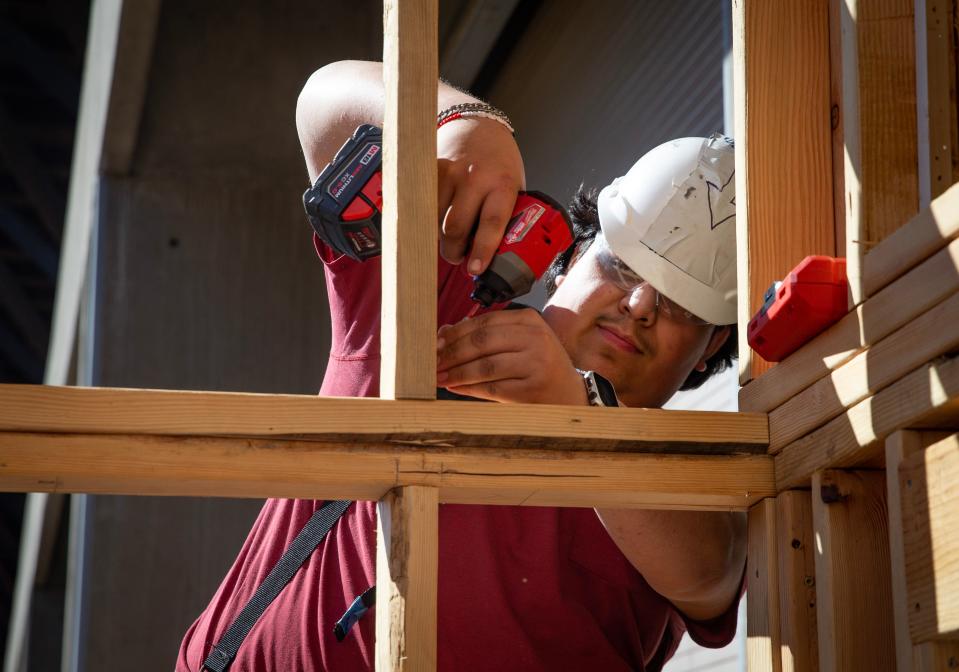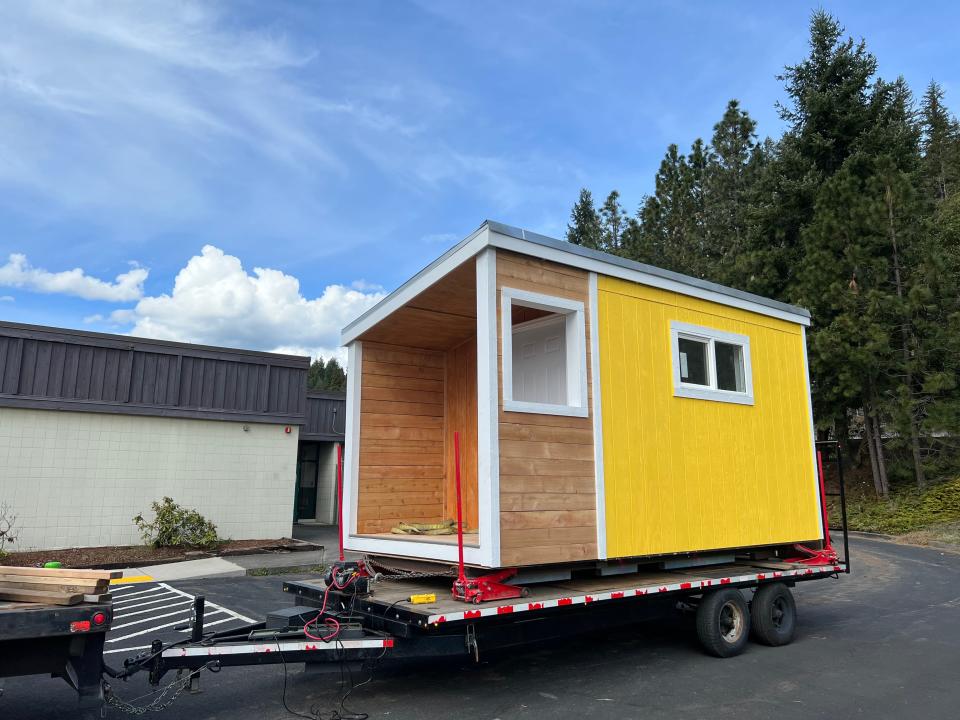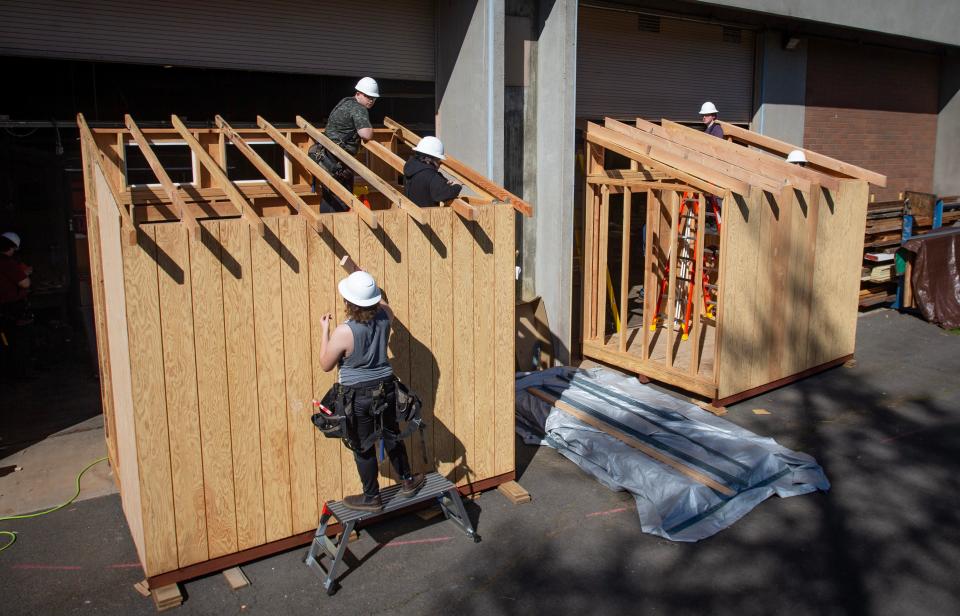Students build 'Brighter Future' for local unhoused populations
Across the county, 15 school districts are building transitional housing shelters as part of the Constructing a Brighter Future project, a collaboration between Lane Education Services District and Lane Workforce Partnership.
High school students are making progress on their shelters, with 30 structures on track to be completed by the end of the school year in June.
Since beginning in September, Eugene School District 4J career and technical education teacher Wheylin Niehus said the students spent part of their day at Lane Community College with part in-classroom time where they learn about safety, math skills, blueprint comprehension, tool usage, communication and employability. Then, they transition to the work space where − under professional guidance − they get to work constructing.
"It's just been super rewarding ... watching the growth, watching the skills, watching the self-confidence, that self-agency of getting better," Niehus said. "It's fun to build, you feel good. It's like, 'Oh, this is cool. I did that.' But now it's 'I'm also helping out the community.'"

The structures are completely mobile. The students are building them at their school site, and they can be transported as needed. Many will be distributed between Everyone Villages and Square One for unhoused populations.
The structures are 8x12 — 8x16, including the porch — and have insulation, which will be beneficial during the summer and winter months. Although they do not have plumbing for a bathroom or kitchen, they are a big step up from living on the street, Lane ESD CTE construction trades specialist Lee Kounovsky said.
Kounovsky said up to 60% of inhabitants of these types of shelters entered more traditional housing within a year.
"They're strictly a shelter, a transitional shelter until people can get whatever they needed to do to get back on their feet," Kounovsky said. "We're not building these as a place to stay forever. It's truly a stepping mechanism."
The first completed student-built structure was unveiled in Oakridge Wednesday.

According to Lane Workforce Partnership, it will be used as a warming shelter, storage space and fit any other needs required in its new home in Greenwaters Park. The structure 4J students are working on will be completed in June.
"It's really nice that we are able to do this at school," Aiden Riley, a senior at North Eugene High, said. "We can help out the community instead of just sitting in a classroom."
Building in action
By the end of the year, not only will the students have fully completed structures, but they will have certifications.
The students go through training and certification for National Center for Construction Education and Research and Occupational Safety and Health Administration 10. Both certifications are nationally recognized and give them a leg up if they choose to pursue a trade career.

"They pay for the courses and we actually get certifications for them," Sheldon High senior Bomin Frazier said. "That'll definitely come in handy."
Students also earn high school credits for math and language arts, because they learn how to read blueprints and site plans. They can also receive college credits through LCC's College Now program.
For hands-on projects, the 4J class' time is split among the Constructing a Brighter Future transitional housing projects, the Future Build low-income house construction and the new Sheducation initiative for storage space.
Frazier said he joined the class to try something different, and over the months the group has come together as a family.
"Physical work, like, it makes us happier," Frazier said. "In a standard high school class, there's only one teacher in there, you just have a bunch of kids sitting in desks and they could pretty much just doze off with no repercussions or anything. You can't really do that here."
Funding for another year?
Lee Kounovsky, CTE construction trades specialist for Lane ESD, said the Constructing a Brighter Future program is looking for additional funding.
Each structure will cost about $3,500. A bulk of the funding for the project comes from the Oregon Department of Education’s CTE Revitalization Grant, but funding has also come from Lane County Economic Development, Future Ready Oregon, Roundhouse Foundation and private donors.
Kounovsky said after the schools complete the first round of structures, they will have enough funding for about two more. Lane ESD and LWP want to continue the project next school year and have applied for several grants, but funds have not been secured.
"There is a need for these (shelters)," Kounovsky said. "Every time you pass up a blue tent or tarp, somebody else could be in one of these."
The project is looking for community sponsors and professionals to help mentor the students.
To make a contribution, visit lanecte.org/programs/constructing-a-brighter-future.
Miranda Cyr reports on education for The Register-Guard. You can contact her at mcyr@registerguard.com or find her on Twitter @mirandabcyr.
This article originally appeared on Register-Guard: Students build 'Brighter Future' for local unhoused populations

